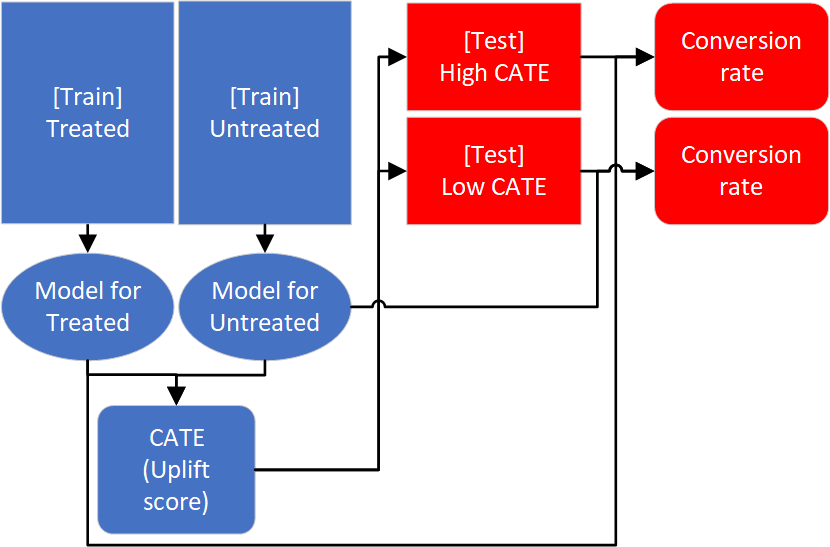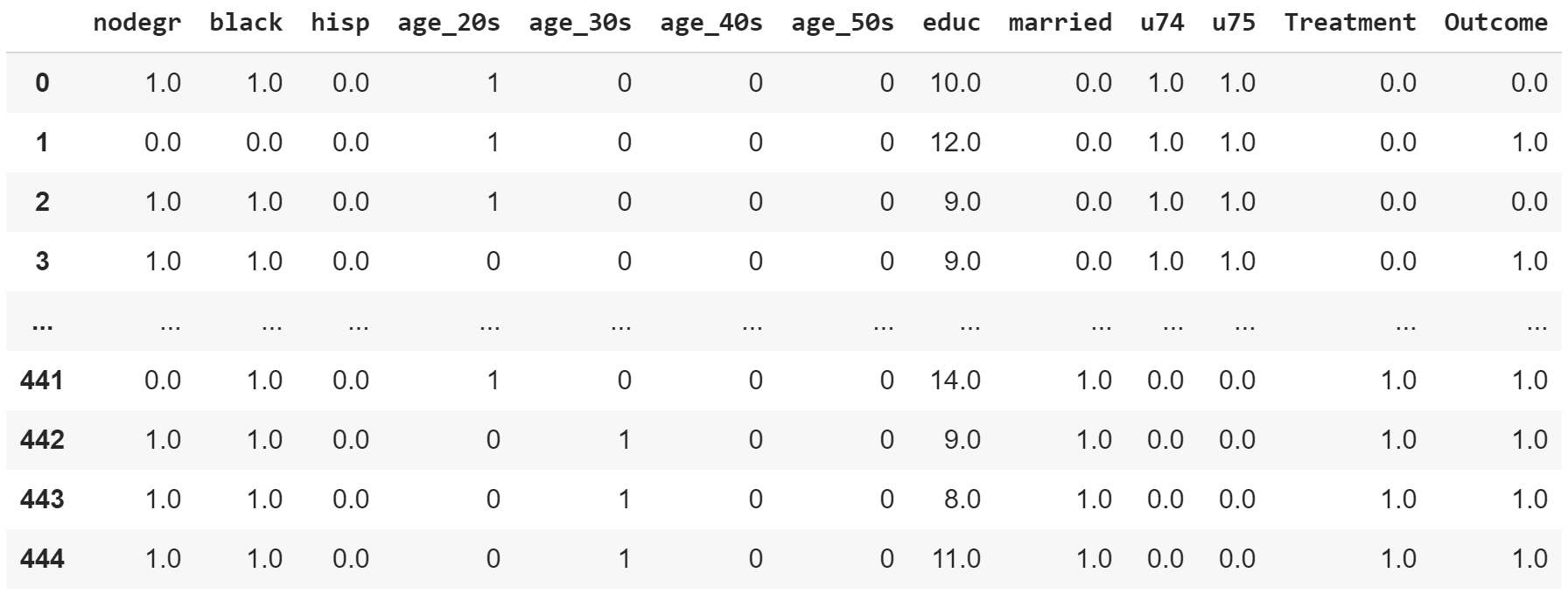CausalLift: Python package for Uplift Modeling in real-world business; applicable for both A/B testing and observational data
Suppose you are responsible for a marketing campaign/promotion (show an advertisement, offer discount, make a phone call, etc.) to some customers to increase revenue or prevent churns. Which one will you choose?
- Strategy A: choose customers who will buy the product (with or without being contacted)
- Strategy B: choose customers who will buy the product if contacted, but will not if not contacted
Strategy B is known as Uplift Modelling.
Suppose you are responsible for recommendation system at a E-commerce company. Which one will you choose?
- Strategy A: recommend a product the user will buy (with or without recommendation)
- Strategy B: recommend a product the user will buy if recommended, but will not if not recommended
Strategy B is known as Uplift Modelling.
Suppose you are trying to make a candidate to be the next US president. Which one will you choose?
- Strategy A: contact voters who will vote for the candidate (with or without being contacted)
- Strategy B: contact voters who will vote for the candidate if contacted, but will not if not contacted
Strategy B is known as Uplift Modelling, and used by Barack Obama in 2012. Here are some articles.
- What is 'Persuasion Modeling', and how did it help Obama to win the elections?
- How Obama's Team Used Big Data to Rally Voters
- How uplift modeling helped Obama's campaign -- and can aid marketers
Suppose you can receive one of the following words of the God of Machine Learning. Which one will you choose?
- Option A: prediction that you will die somewhere next year
- Option B: prediction that you will die if you live in city XXX next year, but will not die if you move to city YYY.
Option B is the analogy of Uplift Modeling.
Uplift Modeling is a Machine Learning technique to find which customers (individuals) should be targeted ("treated") and which customers should not be targeted.
Uplift Modeling is also known as persuasion modeling, incremental modeling, treatment effects modeling, true lift modeling, or net modeling.
Uplift Modeling predicts the following 4 labels:
- True Uplift, aka "Persuadables"
- Customers will buy a product if treated, but will not buy if not treated
- False Uplift, aka "Sure Things"
- Customers will buy a product regardless of the treatment
- True Drop, aka "Sleeping Dogs"/"Do Not Disturbs"
- Customers who will not buy a product if treated, but will buy if not treated
- False Drop, aka "Lost Causes"
- Customers will not buy a product regardless of the treatment
Uplift Modeling estimates uplift scores (a.k.a. CATE: Conditional Average Treatment Effect or ITE: Individual Treatment Effect). Uplift score is how much the estimated conversion rate will increase by the campaign.
Suppose you are in charge of a marketing campaign to sell a product, and the estimated conversion rate (probability to buy a product) of a customer is 50 % if targeted and the estimated conversion rate is 40 % if not targeted, then the uplift score of the customer is (50-40) = +10 % points. Likewise, suppose the estimated conversion rate if targeted is 20 % and the estimated conversion rate if not targeted is 80%, the uplift score is (20-80) = -60 % points (negative value).
The range of uplift scores is between -100 and +100 % points (-1 and +1). It is recommended to target customers with high uplift scores and avoid customers with negative uplift scores to optimize the marketing campaign.
- CausalLift works with both A/B testing results and observational datasets.
- CausalLift can output intuitive metrics for evaluation.
In a word, to use for real-world business.
-
Existing packages for Uplift Modeling assumes the dataset is from A/B Testing (a.k.a. Randomized Controlled Trial). In real-world business, however, observational datasets in which treatment (campaign) targets were not chosen randomly are more common especially in the early stage of evidence-based decision making. CausalLift supports observational datasets using a basic methodology in Causal Inference called "Inverse Probability Weighting" based on the assumption that propensity to be treated can be inferred from the available features.
-
There are 2 challenges of Uplift Modeling; explainability of the model and evaluation. CausalLift utilizes a basic methodology of Uplift Modeling called Two Models approach (training 2 models independently for treated and untreated samples to compute the CATE (Conditional Average Treatment Effects) or uplift scores) to address these challenges.
-
[Explainability of the model] Since it is relatively simple, it is less challenging to explain how it works to stakeholders in the business.
-
[Explainability of evaluation] To evaluate Uplift Modeling, metrics such as Qini and AUUC (Area Under the Uplift Curve) are used in research, but these metrics are difficult to explain to the stakeholders. For business, a metric that can estimate how much more profit can be earned is more practical. Since CausalLift adopted the Two-Model approach, the 2 models can be reused to simulate the outcome of following the recommendation by the Uplift Model and can estimate how much conversion rate (the proportion of people who took the desired action such as buying a product) will increase using the uplift model.
-
CausalLift flow diagram
CausalLift internal pipeline (visualized by Kedro Viz)
- Python 3.5
- Python 3.6 (Tested and recommended)
- Python 3.7
$ pip install python-json-logger<=2.0.4 kedro<=0.17.7 scikit-learn<=0.21.3 numpy pandas easydictNote:
- Python 3.8 or later is not supported yet.
- scikit-learn 0.22 or later is not supported yet.
- kedro 0.18 or later is not supported yet.
- [Option 1] To install the latest release from the PyPI:
$ pip install causallift- [Option 2] To install the latest pre-release:
$ pip install git+https://github.com/Minyus/causallift.git- [Option 3] To install the latest pre-release without need to reinstall even after modifying the source code:
$ git clone https://github.com/Minyus/causallift.git
$ cd pipelinex
$ python setup.py develop- matplotlib
- xgboost
- scikit-optimize
- kedro-viz
Prepare the following columns in 2 pandas DataFrames, train and test (validation).
- Features
- a.k.a independent variables, explanatory variables, covariates
- e.g. customer gender, age range, etc.
- Note: Categorical variables need to be one-hot coded so propensity can be estimated using logistic regression. pandas.get_dummies can be used.
- Outcome: binary (0 or 1)
- a.k.a dependent variable, target variable, label
- e.g. whether the customer bought a product, clicked a link, etc.
- Treatment: binary (0 or 1)
- a variable you can control and want to optimize for each individual (customer)
- a.k.a intervention
- e.g. whether an advertising campaign was executed, whether a discount was offered, etc.
- Note: if you cannot find a treatment column, you may need to ask stakeholders to get the data, which might take hours to years.
- [Optional] Propensity: continuous between 0 and 1
- propensity (or probability) to be treated for observational datasets (not needed for A/B Testing results)
- If not provided, CausalLift can estimate from the features using logistic regression.
Example table data
Step 1: Prepare for Uplift modeling and optionally estimate propensity scores using a supervised classification model
If the train_df is from observational data (not A/B Test), you can set enable_ipw=True so IPW (Inverse Probability Weighting) can address the issue that treatment should have been chosen based on a different probability (propensity score) for each individual (e.g. customer, patient, etc.)
If the train_df is from A/B Test or RCT (Randomized Controlled Trial), set enble_ipw=False to skip estimating propensity score.
Train 2 supervised classification models (e.g. XGBoost) for treated and untreated samples independently and compute estimated CATE (Conditional Average Treatment Effect), ITE (Individual Treatment Effect), or uplift score.
This step is the Uplift Modeling consisting of 2 sub-steps:
-
Training using train_df (Note:
TreatmentandOutcomeare used) -
Prediction of CATE for train_df and test_df (Note: Neither
TreatmentnorOutcomeis used.)
Estimate how much conversion rate will increase by selecting treatment (campaign) targets as recommended by the uplift modeling.
You can optionally evaluate the predicted CATE for train_df and test_df (Note: CATE, Treatment and Outcome are used.)
This step is optional; you can skip if you want only CATE and you do not find this evaluation step useful.
There are 2 ways:
- [Deprecated option] Use
causallift.CausalLiftclass interface - [Recommended option] Use
causallift.nodessubpackage withPipelineXpackage
Please see the demo code in Google Colab (free cloud CPU/GPU environment):
To run the code, navigate to "Runtime" >> "Run all".
To download the notebook file, navigate to "File" >> "Download .ipynb".
Here are the basic steps to use.
from causallift import CausalLift
""" Step 1. """
cl = CausalLift(train_df, test_df, enable_ipw=True)
""" Step 2. """
train_df, test_df = cl.estimate_cate_by_2_models()
""" Step 3. """
estimated_effect_df = cl.estimate_recommendation_impact()[Recommended option] Use causallift.nodes subpackage with PipelineX package
Please see PipelineX package and use PipelineX Causallift example project.
Use the whole historical data (A/B Test data or observational data) as train_df instead of splitting into tran_df and test_df, and use the new data with Treatment and Outcome unknown as test_df.
This is possible because Treatment and Outcome are not used for prediction of CATE after Uplift Model is trained using Treatment and Outcome.
Please note that valid evaluation for test_df will not be available as valid Treatment and Outcome are not available.
Please see [CausalLift API document].
-
Uplift Modeling based on Transformed Outcome method for A/B Testing data and visualization of metrics such as Qini.
-
"EconML" (ALICE: Automated Learning and Intelligence for Causation and Economics) [documentation]
Several advanced methods to estimate CATE from observational data.
-
Visualization of steps in Causal Inference for observational data.
-
Propensity Score Matching for observational data.
-
Platform for adaptive experiments, powered by BoTorch, a library built on PyTorch
-
Uplift Modeling.
-
Uplift Modeling and utility tools for quantization of continuous variables, visualization of metrics such as Qini, and automatic feature selection.
-
Propensity Score Matching for observational data.
-
"CausalImpact" [documentation]
Causal inference using Bayesian structural time-series models
-
Gutierrez, Pierre. and G´erardy, Jean-Yves. Causal inference and uplift modelling: A review of the literature. In International Conference on Predictive Applications and APIs, pages 1-13, 2017.
-
Athey, Susan and Imbens, Guido W. Machine learning methods for estimating heterogeneous causal effects. Stat, 2015.
-
Yi, Robert. and Frost, Will. (n.d.). Pylift: A Fast Python Package for Uplift Modeling. Retrieved April 3, 2019, from https://tech.wayfair.com/2018/10/pylift-a-fast-python-package-for-uplift-modeling/
- <Medium article: Uplift Models for better marketing campaigns (Part 1)>
- <Medium article: Simple Machine Learning Techniques To Improve Your Marketing Strategy: Demystifying Uplift Models>
- <Wikipedia: Uplift_modelling>
- Support Python>=3.8, kedro>=0.18, and scikit-learn>=0.23
- Improve documentation
- Clarify the model summary output including visualization
- Add examples of applying uplift modeling to more publicly available datasets (such as Lending Club Loan Data as pymatch did.
- Support for multiple treatments
Any feedback is welcome!
Please create an issue for questions, suggestions, and feature requests.
Please open pull requests to improve documentation, usability, and features against develop branch.
Separate pull requests for each improvement are appreciated rather than a big pull request. It is encouraged to use:
- Google-style docstrings
- PEP 484 comment-style type annotation although Python 2 is not supported.
- An intelligent IDE such as PyCharm or VS Code
If you could write a review about CausalLift in any natural languages (English, Chinese, Japanese, etc.) or implement similar features in any programming languages (R, SAS, etc.), please let me know. I will add the link here.
[English] Causal Inference, Counterfactual, Propensity Score, Econometrics
[中文] 因果推断, 反事实, 倾向评分, 计量经济学
[日本語] 因果推論, 反事実, 傾向スコア, 計量経済学
Yusuke Minami



